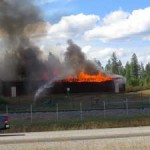There are times when I wonder if some of our clients lay awake at night trying to think up new questions to ask our Hansen Pole Buildings’ Designers, which have never been asked before. In today’s question – Building Designer Brenda was asked what the “burn time” is on one of our buildings.
Of course I asked Brenda specifically what her client was looking for (seems there is always a Paul Harvey), however we have not gotten a reply, as of this writing.
I’ve written in the past about the fire resistance of wood: https://www.hansenpolebuildings.com/blog/2012/04/fire-resistance-of-wood/
 Pole (post frame) buildings, without special provisions being made, are not inherently any more fire resistive (or fire yielding) than the average stick frame structure. Think about it – they are both wood frameworks, so pole building burn time is comparative.
Pole (post frame) buildings, without special provisions being made, are not inherently any more fire resistive (or fire yielding) than the average stick frame structure. Think about it – they are both wood frameworks, so pole building burn time is comparative.
Methods are available to establish fire resistance, both as tested and prescriptive assemblies. https://www.hansenpolebuildings.com/blog/2013/11/establishing-fire-resistance/
The American Wood Council publishes the NDS® (National Design Specification® for Wood Construction). Their Technical Report No. 10 contains formulas for Calculating the Fire Resistance of Exposed Wood Members. For those of you who are aspiring engineers or just enjoy playing with numbers and complicated formulas (and have an excess of time of your hands) it can be perused here: https://www.awc.org/pdf/tr10.pdf.
Much has been made, in the building community, as a resultant of the January 21, 2015 fire at a 240 unit Edgewater apartment complex fire. You can see the video here: https://search.yahoo.com/search;_ylt=A0LEVzNx12FVEoQAsBVXNyoA;_ylc=X1MDMjc2NjY3OQRfcgMyBGZyA2NybWFzBGdwcmlkA0JTbXJyUkZDU0VhNzFiUkhhQnYyb0EEbl9yc2x0AzAEbl9zdWdnAzQEb3JpZ2luA3NlYXJjaC55YWhvby5jb20EcG9zAzAEcHFzdHIDBHBxc3RybAMEcXN0cmwDMzEEcXVlcnkDRWRnZXdhdGVyIGFwYXJ0bWVudCBmaXJlIHZpZGVvcwR0X3N0bXADMTQzMjQ3NTc2Ng–?p=Edgewater+apartment+fire+videos&fr2=sb-top-search&fr=crmas
The fire prompted talk of legislation to toughen building codes. Fire officials who responded to the fire said it was worsened by lightweight materials, such as engineered wood, and an open, truss style roof.
“All wood burns, it doesn’t matter if its solid wood or little chunks glued together,” said Daniel Madrzykowski, a fire protection engineer with the National Institute of Standards and Technology, a part of the U.S. Department of Commerce. The difference, he said, is a solid piece will take more energy from a fire to ignite and will burn longer before it loses its strength.
Back to pole building burn time…..the dictate of failure due to fire will be a resultant of the weakest link in the chain. Without the use of fire retardant treated lumber, sprinkler systems, or fire walls – it comes down to how quickly will a nominal two inch thick piece of lumber burn through?
In a typical pole building, roof purlins and floor joists (in multiple floored buildings) are likely to be the weak links which would result in a potential collapse. In the AWC NDS Technical Report No. 10, Appendix B, Table B1, is given the “Design Load Ratio Limits for Solid Wood Joists”. Whether 2×6 or 2×12, a member supporting no load (think of a roof with no snow), has a 20.4 minute structural fire resistance time. When loaded to 100% of capacity, the same members are good for 10.6 to 11.3 minutes.
Why might these numbers be the same? Because the members least dimension is the 1-1/2” thickness! This, in my humble opinion, is one more reason the Hansen Pole Buildings actual double truss system is advantageous. The trusses are physically connected together, creating a three inch thick member – hence potentially doubling the time for a structural failure due to fire.






